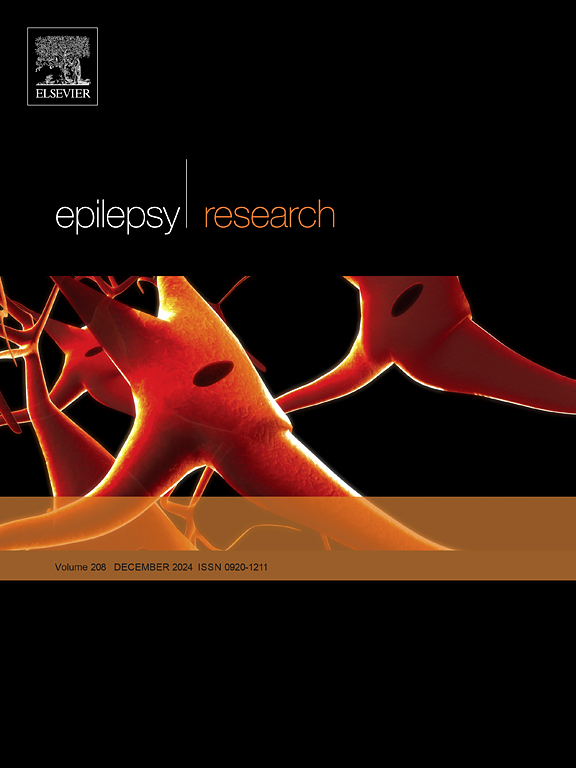kcnt1相关性癫痫大鼠模型的功能评价
IF 2
4区 医学
Q3 CLINICAL NEUROLOGY
引用次数: 0
摘要
目的kcnt1编码钠活化钾通道,其变异可导致难治性癫痫。KCNT1变异相关癫痫对抗癫痫药物的耐药性提示存在复杂的基因调控。我们的目标是阐明与癫痫相关的KCNT1变异的致病性。方法研究Kcnt1-269变异(c.805)的致病性G 祝辞 c.807G 祝辞 C, p.G269S;对应于c.862G >; A, p.G288S在人体内),并通过RNA测序分析大鼠大脑皮层的转录组。结果Kcnt1-269纯合子变异大鼠在CA1锥体神经元中表现出过度的神经兴奋性,包括神经元动作电位振幅增强,动作电位阈值降低,神经元放电数量增加。纯合子和杂合子Kcnt1-269变异大鼠在不同阶跃电流下的诱发动作电位频率较高。纯合子Kcnt1-269变异大鼠诱导癫痫发作所需的戊四唑累积剂量明显低于野生型大鼠。与野生型大鼠相比,杂合Kcnt1-269变异大鼠的大脑皮层转录组分析发现190个基因上调,149个基因下调。功能富集分析显示,“核仁”、“神经肽信号通路”、“树突”和“蛋白结合”是基因本体中最突出的术语,而“神经活性配体-受体相互作用”是京都基因与基因组百科全书中最重要的术语之一。结论我们的研究结果阐明了Kcnt1-269变异在大鼠中的致痫性,并可能通过转录组分析为Kcnt1变异相关癫痫的相关途径提供新的见解。本文章由计算机程序翻译,如有差异,请以英文原文为准。
Functional evaluation of a rat model of KCNT1-related epilepsy
Objective
KCNT1 encodes a sodium-activated potassium channel, and its variant can lead to refractory epilepsy. The resistance to antiseizure medication in KCNT1 variant–related epilepsy suggests the presence of complex gene regulation. Our goal is to clarify the pathogenicity of a KCNT1 variant associated with epilepsy.
Methods
Here, we intended to characterize the pathogenicity of the Kcnt1-269 variant (c.805 G > A, c.807 G > C, p.G269S; corresponding to c.862 G > A, p.G288S in human) in vitro and in vivo, and to analyze the transcriptome of the rat cerebral cortex through RNA sequencing.
Results
Our study revealed that homozygous Kcnt1-269 variant rats showed excessive neuroexcitability in CA1 pyramidal neurons, including enhanced neuronal action potential amplitudes, decreased action potential thresholds, and increased neuronal firing numbers. Homozygous and heterozygous Kcnt1-269 variant rats had high frequency of evoked action potential under different step currents. The cumulative dose of pentetrazol required to induce epileptic seizures in homozygous Kcnt1-269 variant rats was significantly lower compared with wild-type rats. Transcriptome analysis of the cerebral cortex identified 190 upregulated and 149 downregulated genes in heterozygous Kcnt1-269 variant rats compared with wild-type rats. Functional enrichment analysis revealed that "nucleolus," "neuropeptide signaling pathway," "dendrite," and "protein binding" were the most prominent Gene Ontology terms, while "neuroactive ligand–receptor interaction" was one of the most significant Kyoto Encyclopedia of Genes and Genomes terms.
Conclusion
Our findings elucidate the epileptogenicity of the Kcnt1-269 variant in rats and may provide new insights into the pathways associated with Kcnt1 variant–related epilepsy through transcriptome analysis.
求助全文
通过发布文献求助,成功后即可免费获取论文全文。
去求助
来源期刊

Epilepsy Research
医学-临床神经学
CiteScore
0.10
自引率
4.50%
发文量
143
审稿时长
62 days
期刊介绍:
Epilepsy Research provides for publication of high quality articles in both basic and clinical epilepsy research, with a special emphasis on translational research that ultimately relates to epilepsy as a human condition. The journal is intended to provide a forum for reporting the best and most rigorous epilepsy research from all disciplines ranging from biophysics and molecular biology to epidemiological and psychosocial research. As such the journal will publish original papers relevant to epilepsy from any scientific discipline and also studies of a multidisciplinary nature. Clinical and experimental research papers adopting fresh conceptual approaches to the study of epilepsy and its treatment are encouraged. The overriding criteria for publication are novelty, significant clinical or experimental relevance, and interest to a multidisciplinary audience in the broad arena of epilepsy. Review articles focused on any topic of epilepsy research will also be considered, but only if they present an exceptionally clear synthesis of current knowledge and future directions of a research area, based on a critical assessment of the available data or on hypotheses that are likely to stimulate more critical thinking and further advances in an area of epilepsy research.
 求助内容:
求助内容: 应助结果提醒方式:
应助结果提醒方式:


